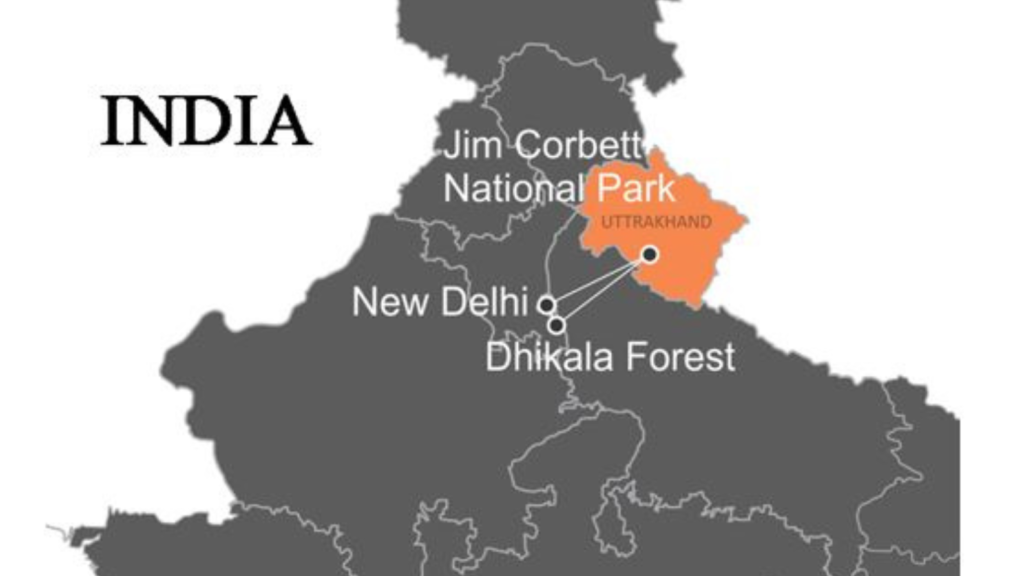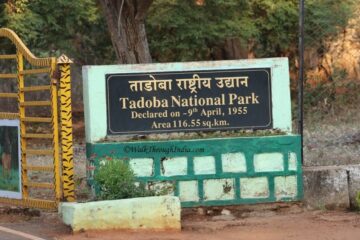
The Nainital district in the Indian state of Uttarakhand is home to Jim Corbett National Park. As the country’s first national park, it was created in 1936 during the British Raj and given the name Hailey National Park in honor of William Malcolm Hailey, the United Provinces’ governor at the time. It was renamed Corbett National Park in 1956, over ten years after India gained independence, in honor of the hunter and naturalist Jim Corbett, who had been instrumental in its founding and had passed away the year before. The Project Tiger initiative’s original location was the park.
The 520.8 km2 (201.1 sq mi) expanse of hills, riverine belts, marshy depressions, grasslands, and a sizable lake make up Corbett National Park. The elevation varies from 400 to 1,220 meters, or 1,300 to 4,000 feet. While the days are bright and beautiful in winter, the evenings are chilly. From July through September, it rains. The park exhibits geological and biological aspects of the sub-Himalayan area. Shorea robusta (also known as the sal tree), haldu, peepal, rohini, and mango trees make up the majority of the dense damp deciduous forest. Almost 73% of the park is covered in forest, while 10% of it is made up of meadows. It is home to 25 reptile species, 110 tree species, 50 animal species, and 580 bird species.
The park is a popular tourist destination with 617 distinct plant species and a wide range of wildlife. Along with other issues, the rise in visitor activity continues to pose a significant threat to the natural balance of the park.

History:
A portion of the park was previously a part of the Tehri Garhwal princely state. To reduce the area’s susceptibility to Rohilla invasion, the Environment and trees Department (Uttarakhand) removed the trees. In exchange for the East India Company’s aid in driving the Gurkhas out of his dominion, the Raja of Tehri legally gave a portion of his princely kingdom to them. A tribe from the Terai called the Buksas lived there and started farming crops, but when British administration arrived in the early 1860s, they were forced to leave.
Under Major Ramsay, the British officer in command of the area at the time, efforts to conserve the region’s woods got underway in the 19th century. The British Forest Department took jurisdiction over the land and forbade cultivation and the operation of cattle stations in 1868, marking the beginning of the first phase of the area’s preservation. These woodlands were established as a reserve forest in 1879, allowing for only limited felling.
Several Britons, notably E. R. Stevans and E. A. Smythies, proposed the creation of a national park on this land in the early 1900s. In 1907, the British government explored the idea of establishing a game reserve there. The process of dividing such a region did not begin until the 1930s. In 1936, while Sir Malcolm Hailey was the Governor of the United Provinces, a reserve area known as Hailey National Park, with a surface area of 323.75 km2 (125.00 sq mi), was established; this marked the establishment of Asia’s first national park.In the reserve, only timber harvesting for residential use was permitted. Rules banning the killing and catching of animals, reptiles, and birds inside the reserve’s limits were approved not long after it was established.
After novelist and naturalist Jim Corbett, the reserve was renamed Ramganga National Park in 1954–1955, and then Corbett National Park in 1955–1956.
Under an elected leadership, the park prospered well during the 1930s. However, it suffered from rampant poaching and timber cutting during the Second World War. The size of the reserve has grown over time; in 1991, a buffer zone of 797.72 km2 (308.00 sq mi) was added to the Corbett Tiger Reserve. The Sonanadi Wildlife Sanctuary’s 301.18 km2 (116.29 sq mi) land was absorbed into the Kalagarh division as part of the 1991 expansion, which covered the entirety of the Kalagarh forest division. It was selected in 1974 as the site for the beginning of Project Tiger, a wildlife conservation initiative.From its headquarters in the Nainital district, the reserve is run.
One of the thirteen protected places included in the Terai Arc Landscape Program of the World Wide Fund For Nature is Corbett National Park. Through the restoration of forest corridors that connect 13 protected areas in Nepal and India and allow for animal migration, the initiative seeks to safeguard three of the five terrestrial flagship species: the tiger, the Asian elephant, and the great one-horned rhinoceros.
Geography:
The park may be found between latitudes 78°44′ and 79°07’E and directions 29°25′ and 29°39’N. The area is between 360 m (1,181 ft) and 1,040 m (3,412 ft) above sea level. Numerous hills, ravines, tiny streams, and plateaus with varied faces and slopes are present. The Patli Dun valley, which the river Ramganga created, is included in the park. It safeguards a portion of the Himalayan subtropical pine forests and the wet deciduous woods of the Upper Gangetic Plains. Its climate is highland subtropical and humid.
The reserve now spans 1,288.31 square kilometers (497.42 square miles), with a 466.31 square kilometer (180.04 square mile) buffer area and an 822-square-kilometer (317-square-kilometer) core zone. The buffer is made up of reserve forests (496.54 square kilometers, or 191.72 square miles), as well as the Sonanadi Wildlife Sanctuary (301.18 square kilometers, or 116.29 square miles), whereas the center is the Jim Corbett National Park.
The reserve has a sub-Himalayan belt structure and is situated partially along Doon Valley between the Lesser Himalaya in the north and the Shivaliks in the south. Near the Shiwalik range’s foot, the upper tertiary rocks are visible, and vast ridges of hard sandstone are formed. Along the narrow tectonic zones between lineaments, distinctive longitudinal valleys that geologists refer to as Doons or Duns may be observed forming.
Climate:
Compared to most other Indian protected areas, the park has a moderate climate. During the winter, the temperature can range from 5 °C (41 °F) to 30 °C (86 °F), and some mornings are foggy. Normal summertime highs don’t exceed 40 °C (104 °F). Light rain falls in the winter and torrential rain falls in the monsoonal summer.
Flora:
The Anogeissus-Acacia catechu woods have the lowest tree density inside the reserve while the Sal forests have the highest. In regions of woody vegetation where Sal predominates, the total tree basal cover is higher. Mallotus philippensis, Jamun, and Diospyros spp. communities are seeing healthy regeneration in their sapling and seedling layers, while Sal forest regeneration is subpar. In a study survey conducted in the 1970s, 488 distinct plant species were identified; in 2023, 617 species, including 110 tree species, were reported. The sal tree (S. robusta), Adina cordifolia, Anogeissus latifolia, Bauhinia rausinosa, Cassia fistula, and M. philippensis were identified as some of the reserve’s significant tree species in a profile by the Wildlife Institute of India.
Fauna:
The classification of resident and migratory birds includes more than 586 species, including the red junglefowl, the progenitor of all domestic poultry, the blossom-headed parakeet, and the crested serpent eagle. There are also 36 species of dragonflies, 33 species of reptiles, 7 species of amphibians, 7 species of fish.
concealment – in the wilderness. This reserve is the perfect home for tigers, who are opportunistic feeders and prey upon a variety of species due to the dense forest, the Ramganga river, and the abundance of prey. Larger animals like buffalo and even elephants have been reported to be killed by the tigers in the park for food.When food is scarce, which doesn’t happen often, tigers feed on larger animals. In times of a lack of prey, tigers have been known to attack domesticated animals.
Although they occasionally go into lowland forests, leopards are mostly found in steep places. The leopard cat, fishing cat, and jungle cat are examples of small cats seen in the park.Other mammals include langurs, rhesus macaques, yellow-throated martens, Himalayan gorals, Indian pangolins, barking deer, sambar deer, hog deer, and chital, sloths, Himalayan black bears, Indian grey mongooses, and otters. During the night, owls and nightjars can be heard.
Indian elephants can be observed in groups of several hundred throughout the summer. The reserve is home to a hazardous kind of Indian python that is capable of killing a chital deer. Captive breeding efforts that later reintroduced crocodiles into the Ramganga river prevented the extinction of local crocodiles and gharials.
Ecotourism:
The administration of the reserve has promoted ecotourism even though the preservation of animals is the major priority. A training program for nature guides was developed in 1993, including natural history, tourist management, and park explanation. In 1995, a second course was offered, and for that one, more guides were hired.This freed up the reserve’s employees, who had been engaged with directing tourists, to conduct management tasks without interruption. In order to guarantee that locals profit from tourism while the park is preserved, the Indian government has also organized seminars on ecotourism in the Garhwal area and Corbett National Park.
The greatest time to visit the park, according to patil & Joshi (1997), is during the summer (April to June), while the best time for international visitors to go is during the winter (November to January). According to Riley and Riley (2005): “Best chances of seeing a tiger to come late in the dry season- April to mid-June-and go out with mahouts and elephants for several days.”
As early as 1991, the Corbett National Park attracted 3237 tourist vehicles carrying 45,215 passengers during the busiest travel seasons from 15 November to 15 June. Due to this enormous influx of tourists, the natural environment is plainly displaying signs of stress. Due to the demand from visitors, there has been an excessive amount of soil disturbance, which has led to a reduction in soil moisture and a fall in plant species. More and more guests are utilizing wood as fuel for their meals. This is problematic since using fuel wood from nearby forests puts extra pressure on the forest ecosystem of the park. Additionally, visitors have contributed to problems with waste, noise pollution, and general disruptions.
Kahini Ghosh Mehta, a photographer and environmentalist, published the first thorough trip guide to Corbett National Park in 2007. The movie, Wild Saga of Corbett, demonstrates how visitors might aid in conservation efforts.
In popular culture:
The Jim Corbett National Park is the setting for the 2005 Bollywood film Kaal’s narrative. The park also served as the location for the movie.
In an exclusive episode of the Discovery Channel series Man vs. Wild in August 2019, India’s Prime Minister Narendra Modi hiked through the forests and discussed nature and animal conservation with Grylls. The program, which was recorded in India’s Jim Corbett National Park, was shown in 180 nations.
Ecosystem valuation:
The yearly flow benefits of the Jim Corbett Tiger Reserve were assessed by an economic assessment study to be 14.7 billion (1.14 lakh/hectare). Gene-pool protection (10.65 billion), water provision to upstream districts of Uttar Pradesh (1.61 billion), water purification services for the city of New Delhi (550 million), employment for local communities (82 million), habitat and refuge for wildlife (274 million), and carbon sequestration (214 million) were all significant ecosystem services.



